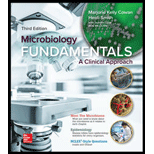
Microbiology Fundamentals: A Clinical Approach
3rd Edition
ISBN: 9781259709227
Author: Marjorie Kelly Cowan Professor, Heidi Smith
Publisher: McGraw-Hill Education
expand_more
expand_more
format_list_bulleted
Concept explainers
Textbook Question
thumb_up100%
Chapter 6.1, Problem 1AYP
List the essential nutrients of a bacterial cell.
Expert Solution & Answer
Want to see the full answer?
Check out a sample textbook solution
Students have asked these similar questions
Please draw in the missing answer, thank you
Please fill in all blank questions, Thank you
please fill in missing parts , thank you
Chapter 6 Solutions
Microbiology Fundamentals: A Clinical Approach
Ch. 6.1 - List the essential nutrients of a bacterial cell.Ch. 6.1 - Prob. 2AYPCh. 6.1 - List and define four different terms that describe...Ch. 6.1 - Prob. 4AYPCh. 6.1 - Compare and contrast the processes of diffusion...Ch. 6.1 - Identify the effects of isotonic, hypotonic, and...Ch. 6.1 - Name two types of passive transport and one type...Ch. 6.1 - Prob. 1NPCh. 6.1 - Prob. 2NPCh. 6.1 - Prob. 3NP
Ch. 6.1 - Prob. 1MMCh. 6.2 - List and define five terms used to express the...Ch. 6.2 - Summarize three ways in which microorganisms...Ch. 6.2 - Identify three important environmental factors...Ch. 6.2 - List and describe the five types of associations...Ch. 6.2 - Discuss characteristics of biofilms that...Ch. 6.2 - Which statements are true with respect to...Ch. 6.3 - Summarize the steps of cell division used by most...Ch. 6.3 - Define doubling time, and describe how it leads to...Ch. 6.3 - Compare and contrast the four phases of growth in...Ch. 6.3 - Identify one culture-based and one...Ch. 6.3 - Prob. 2MMCh. 6 - Which descriptors are likely to have applied to...Ch. 6 - Prob. 2QCh. 6 - Speculate about how earths atmosphere came to...Ch. 6 - Which of the following is true of passive...Ch. 6 - Compare the effects of a hypertonic, hypotonic,...Ch. 6 - Usually scientists looking for life on other...Ch. 6 - An organism that can synthesize all its required...Ch. 6 - Provide evidence in support of or refuting this...Ch. 6 - Develop an explanation for why biofilm bacteria...Ch. 6 - Most bacteria increase their numbers by a. sexual...Ch. 6 - Looking at figure 6.3, explain how a cell in a...Ch. 6 - In binary fission, the parent chromosome is...Ch. 6 - A cell exposed to a hypertonic environment will...Ch. 6 - Prob. 14QCh. 6 - Bacteria and archaea are ubiquitous on the planet....Ch. 6 - Prob. 16QCh. 6 - How can you explain the fact that an unopened...Ch. 6 - Prob. 18QCh. 6 - In a viable count, each ____ represents a ______...Ch. 6 - If an egg salad sandwich sitting in a car on a...Ch. 6 - Scientists now believe that most bacteria in...Ch. 6 - Prob. 1VC
Knowledge Booster
Learn more about
Need a deep-dive on the concept behind this application? Look no further. Learn more about this topic, biology and related others by exploring similar questions and additional content below.Similar questions
- please draw in the answers, thank youarrow_forwarda. On this first grid, assume that the DNA and RNA templates are read left to right. DNA DNA mRNA codon tRNA anticodon polypeptide _strand strand C с A T G A U G C A TRP b. Now do this AGAIN assuming that the DNA and RNA templates are read right to left. DNA DNA strand strand C mRNA codon tRNA anticodon polypeptide 0 A T G A U G с A TRParrow_forwardplease answer all question below with the following answer choice, thank you!arrow_forward
- please draw in the answeres, thank youarrow_forwardA) What is being shown here?B) What is indicated by the RED arrow?C) What is indicated by the BLUE arrow?arrow_forwardPlease identify the curve shown below. What does this curve represent? Please identify A, B, C, D, and E (the orange oval). What is occurring in these regions?arrow_forward
- Please identify the test shown here. 1) What is the test? 2) What does the test indicate? How is it performed? What is CX? 3) Why might the test be performed in a clinical setting? GEN CZ CX CPZ PTZ CACarrow_forwardDetermine how much ATP would a cell produce when using fermentation of a 50 mM glucose solution?arrow_forwardDetermine how much ATP would a cell produce when using aerobic respiration of a 7 mM glucose solution?arrow_forward
- Determine how much ATP would a cell produce when using aerobic respiration to degrade one small protein molecule into 12 molecules of malic acid, how many ATP would that cell make? Malic acid is an intermediate in the Krebs cycle. Assume there is no other carbon source and no acetyl-CoA.arrow_forwardIdentify each of the major endocrine glandsarrow_forwardCome up with a few questions and answers for umbrella species, keystone species, redunant species, and aquatic keystone speciesarrow_forward
arrow_back_ios
SEE MORE QUESTIONS
arrow_forward_ios
Recommended textbooks for you
- Surgical Tech For Surgical Tech Pos CareHealth & NutritionISBN:9781337648868Author:AssociationPublisher:Cengage
 Human Physiology: From Cells to Systems (MindTap ...BiologyISBN:9781285866932Author:Lauralee SherwoodPublisher:Cengage Learning
Human Physiology: From Cells to Systems (MindTap ...BiologyISBN:9781285866932Author:Lauralee SherwoodPublisher:Cengage Learning  Biology 2eBiologyISBN:9781947172517Author:Matthew Douglas, Jung Choi, Mary Ann ClarkPublisher:OpenStax
Biology 2eBiologyISBN:9781947172517Author:Matthew Douglas, Jung Choi, Mary Ann ClarkPublisher:OpenStax

Surgical Tech For Surgical Tech Pos Care
Health & Nutrition
ISBN:9781337648868
Author:Association
Publisher:Cengage

Human Physiology: From Cells to Systems (MindTap ...
Biology
ISBN:9781285866932
Author:Lauralee Sherwood
Publisher:Cengage Learning


Biology 2e
Biology
ISBN:9781947172517
Author:Matthew Douglas, Jung Choi, Mary Ann Clark
Publisher:OpenStax


Microbial Nutrition and Growth; Author: Scientist Cindy;https://www.youtube.com/watch?v=rK3UkyWjkl8;License: Standard YouTube License, CC-BY